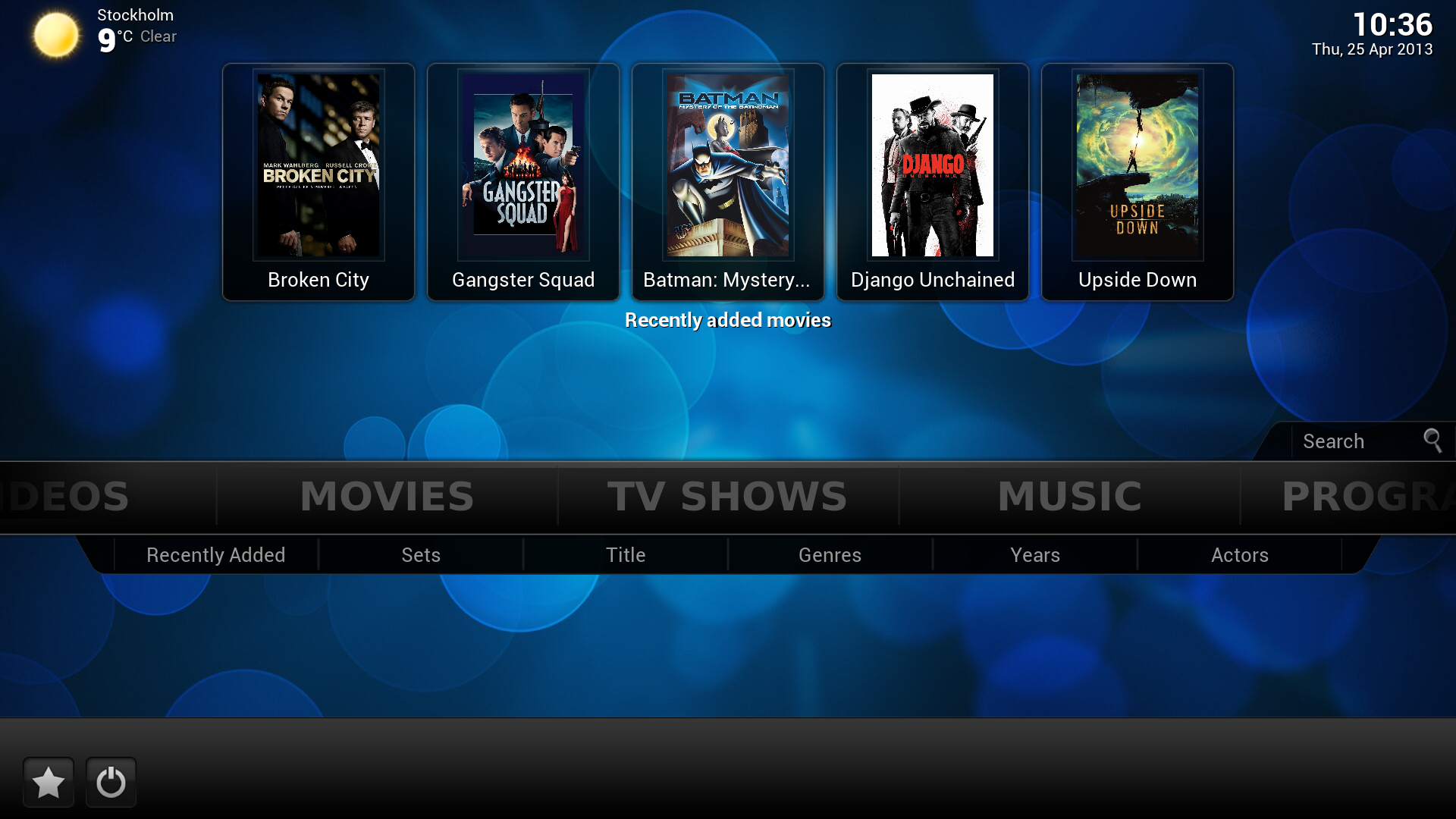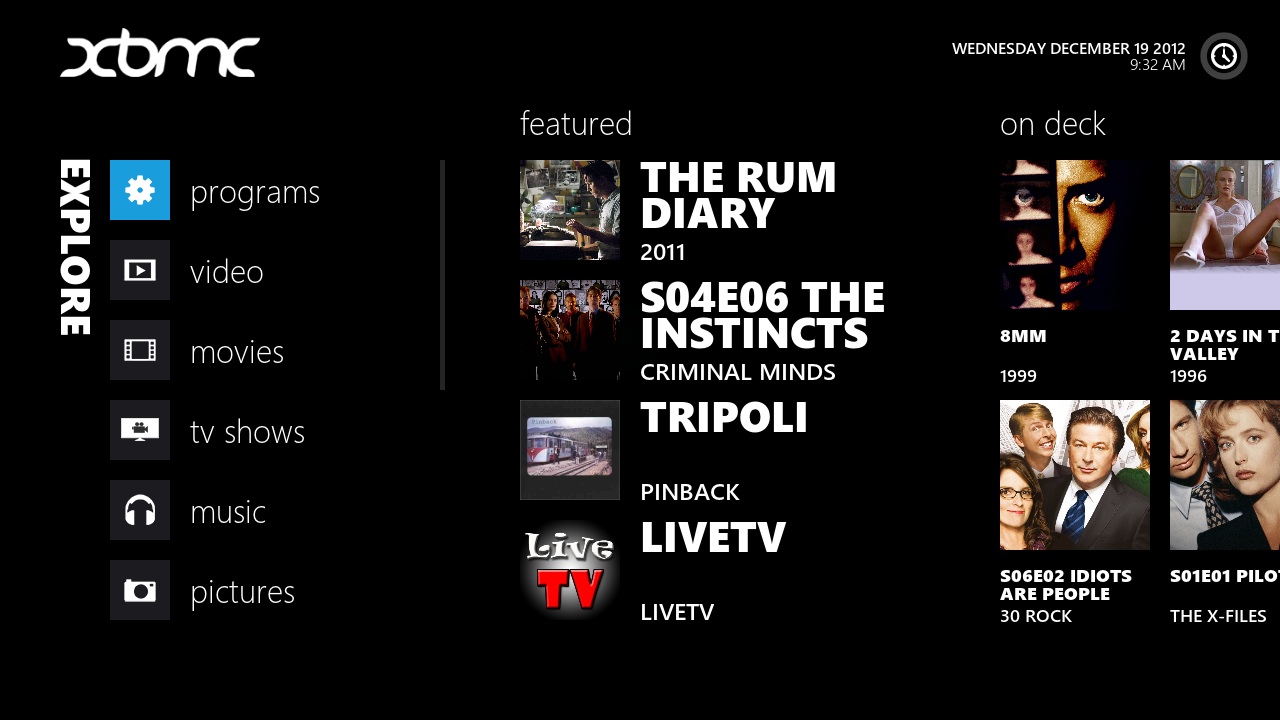Quick start guide: Difference between revisions
No edit summary |
|||
| Line 73: | Line 73: | ||
As you read this wiki and experiment on your own, you will quickly learn about the value of the '''''[[Video library/Navigation#contextual menu|contextual menu]]'''''. | As you read this wiki and experiment on your own, you will quickly learn about the value of the '''''[[Video library/Navigation#contextual menu|contextual menu]]'''''. | ||
To use it, while highlighting an item, press the {{keypress|'''C'''}} key on the keyboard. If you are using a mouse, you can right click while hovering over an item. With remote controls, | To use it, while highlighting an item, press the {{keypress|'''C'''}} key on the keyboard. If you are using a mouse, you can right click while hovering over an item. With remote controls, this is normally the {{button|guide}} button. | ||
== Alternative guides == | == Alternative guides == | ||
Revision as of 01:26, 23 June 2013
Congratulations, new user, in your choice of media center software: XBMC!
This guide is designed to get you up and running with XBMC in the shortest time possible, and was written with the most typical use cases in mind. For more in depth information please refer to the XBMC online wiki manual.
The XBMC interface is designed with the 'Home Theater' in mind. This means it is best viewed on a large-screen TV while you sit on your couch 10-feet away from that TV, rather than on a small monitor while you sit at your desk.
Because everything is designed with the home theater experience in mind, the best way to interact with XBMC is with a remote control, rather than a computer mouse. If it helps, think of XBMC as the ultimate DVD-player/set-top-box.
XBMC main features
- XBMC can be used to play almost all popular audio and video formats.
- Use your media as-is: XBMC can play CDs and DVDs directly from the disk or image file.
- Powerful library that can automatically scan media to retrieve covers, descriptions and fanart from the internet.
- Playlist and slideshow functions
- Flexible, simple to use add-ons that can extend the functions of XBMC
- Network playback built in - stream any playable media from anywhere in the house or internet.
Installing XBMC
If you haven't already done so, download XBMC from http://xbmc.org/download/ or see the installation guides here: Installing
Adding files
While you can just use XBMC with plain file views, adding/scanning files to the library will add rich features such as cover art, summaries, thumbnails, trailers, and more.
To just quickly add files see Adding videos to the library/Adding media sources.
Adding videos to the library
XBMC can search the Internet and automatically find information about your movies and TV shows using scrapers. To be most effective your movie and TV show files should be named according to standard naming conventions.
The filename is referenced by a search within the online records and the closest match is selected. If the filename is not exactly or very close to the movie title the automatic scan may not always offer accurate matches.
Adding music to the library
- See main page: Adding music to the library and Music library
In order to be able to include information on your music collection in the library, XBMC needs your music to be tagged. When your collection is scanned, XBMC stores all the tagging information (artist, album, year, genre, etc) in the database which allows you to efficiently search and manage your music collection. Today most media applications and players (e.g. iTunes / iPod) organize music by this ID tag information.
Note: Your audio files must have a valid ID tag for them to work properly in the XBMC music library.
Adding pictures
Adding sources for your pictures follows the same method as adding other media sources. From the Home Page navigate to Pictures, select Add Source and browse to the location of your picture files.
Using a remote control
Often the most convenient and user friendly way of controlling XBMC is using a remote control. This further enhances the appliance feel of the XBMC and fits next to (or replaces) the other remotes that are likely to be in your entertainment room. MCE Remote controls are usually the cheapest and easiest to use with XBMC, but many other remote controls have been very successfully used with XBMC. Additionally, on Windows and to a more limited extent on Linux, you can use your Xbox 360 controller as a remote, which can be particularly useful in gaming and [w:Video_game_console_emulator|emulator]] setups.
For more information on remote controls and XBMC please explore the links below:
- Remote Control Reviews
- Remote Controls
- Using an MCE remote control in Windows
- Using a remote control with XBMC
- Keyboard controls
- Xbox 360 Wireless Controller for Windows
XBMC Addons
XBMC has the ability to dramatically extend its functionality through the use of add-ons, which provide access to internet media, information, screensavers, services, and more. For a more in-depth explanation, visit the wiki section on XBMC add-ons.
Changing the look and feel of XBMC
XBMC is unlike many contemporary media and gaming centers, in that it can be easily customized to look completely different using skins while still remaining equally as useable and providing access to all your videos, music, and more.
To get new skins, go to: System -> Appearance -> Skin -> Skin Confluence
You will be provided a list of currently installed skins and an option to "Get More..." where you can download additional skins.
- The same home screen using different XBMC skins
Important note about the Context Menu
As you read this wiki and experiment on your own, you will quickly learn about the value of the contextual menu.
To use it, while highlighting an item, press the C key on the keyboard. If you are using a mouse, you can right click while hovering over an item. With remote controls, this is normally the guide button.
Alternative guides
- Lifehacker.com - Create a Kickass, Seamless, Play-Everything Media Center: The Complete Guide
- Makeuseof.com - How to set up your XBMC Media Center
- XBMC Install and Config HOW-TO for Linux Its for xvba, however apart from drivers the rest is a MUST read for Linux novices.





